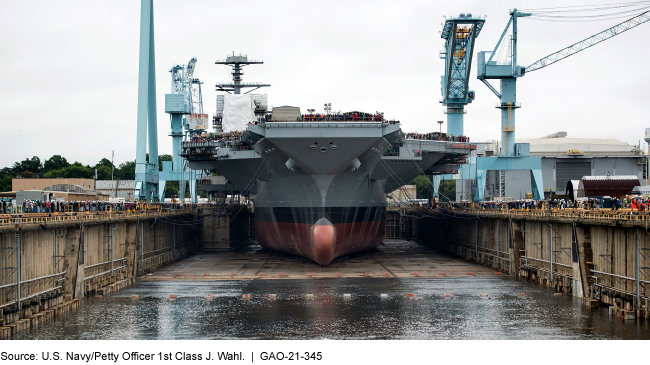Aircraft Carriers: Homeport Changes Are Primarily Determined by Maintenance Requirements
Fast Facts
The Navy relies on 11 aircraft carriers based in ports on the East and West Coasts and in Japan to support U.S. defense objectives. These nuclear-powered ships require complex maintenance that may not be available near their homeports. When a ship changes homeports, more than 5,000 people may have to move: 3,200 crew and their families.
The Navy annually updates its plan for positioning its forces worldwide. Fleet commanders then identify a need for any changes to homeports and submit change requests.
Maintenance—the need for a dry-dock, for example—was the driving factor for all 15 carrier homeport changes the Navy made in FYs 2011-2020.
Aircraft Carrier in a Dry Dock in Newport News, Virginia

Highlights
What GAO Found
The Navy has a process for proposing and implementing homeport changes that considers a range of factors. The first key step in this process involves the Navy developing and updating an annual plan, known as the Strategic Laydown and Dispersal Plan, that guides the Navy's positioning of operating forces worldwide. Based on the plan, fleet commanders then identify requirements for any changes to homeports and submit requests to schedule a homeport change. Throughout the process, Navy leadership and a working group of stakeholders from across the Navy provide input and analysis. Among other things , the working group develops and assesses proposed changes among the possible aircraft carrier homeports based on their expertise and evaluates various homeport installation factors, such as maintenance dry docks (see figure) or ship power and maintenance facilities. The Navy also considers local factors including crew support and quality of life, such as schools and morale, and possible impacts to the natural and physical environment. The Navy has strengthened its process by implementing prior GAO recommendations, and has other planned actions underway to further improve and update its guidance.
Recent Navy Aircraft Carrier Homeport Locations and Dry Dock at Puget Sound Naval Shipyard

The Navy made 15 aircraft carrier homeport changes in fiscal years 2011 through 2020 among the five available homeports. The driving factor for all 15 changes was maintenance. For example, 10 of the 15 changes involved ships moving to or returning from shipyards in Bremerton or Norfolk for planned dry-dock maintenance or midlife refueling. In 2015 and 2019, the Navy decided to homeport aircraft carriers in Bremerton and San Diego because Everett lacked nuclear maintenance facilities, which were available at the Navy's other aircraft carrier homeport locations. Previously, carriers homeported in Everett received regularly scheduled maintenance at the shipyard in Bremerton but did not conduct an official homeport change. The Navy reported that during these maintenance periods that lasted 6 months or more, the crew commuted 3 to 4 hours daily, which negatively affected maintenance and crew morale. As a result, the Navy decided not to return an aircraft carrier to Everett. According to Navy officials, factors in addition to maintenance needs also informed the changes, including a long-held plan to homeport three aircraft carriers in San Diego.
Why GAO Did This Study
The Navy relies on 11 aircraft carriers homeported on the East and West Coasts and in Japan to support U.S. defense strategic objectives and operations. These nuclear-powered ships require complex infrastructure, technology, and maintenance, some of which may not be available near their homeport.
Changing an aircraft carrier's homeport means moving the ship's approximately 3,200 sailors, a fluctuation of 5,000 or more people depending on the number of family members involved. In House Report 116-120, accompanying a bill for the National Defense Authorization Act for Fiscal Year 2020, the House Armed Services Committee noted that the Navy reversed previous plans to homeport an aircraft carrier at Naval Station Everett, Washington.
The House Report also included a provision for GAO to review the Navy's process to assign aircraft carriers' homeports. This report examines, for Navy aircraft carriers, (1) the extent to which the Navy has a process for making homeport changes, and considers local installation and other factors in the homeporting process, and (2) homeport changes from fiscal years 2011 through 2020 and the reasons for them.
GAO analyzed Navy instructions and related policies, laws, and regulations; homeport plans and maintenance schedules; and fiscal years 2011–2020 documentation of homeport changes. GAO also interviewed Navy officials, including from relevant commands and homeports.
For more information, contact Diana Maurer at (202) 512-9627 or MaurerD@gao.gov.
